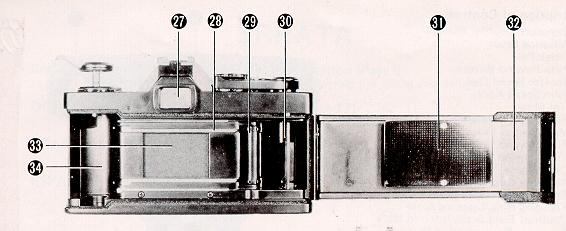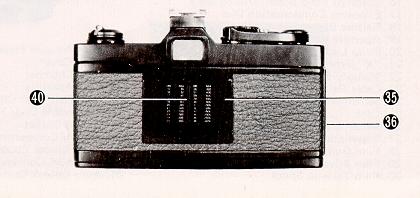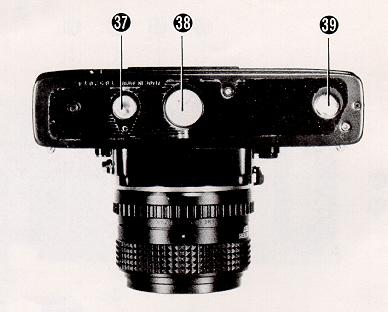and historical purposes, all rights reserved.
This page is copyright© by
This page may not be sold or distributed without
the expressed permission of the producer
I have no connection with any camera company
If you find this manual useful,
how about a donation of
$3 to:
M. Butkus, 29 Lake Ave.,
High Bridge, NJ 08829-1701
and send your e-mail
address
so I can thank you.
Most other places would charge
you $7.50 for
a electronic copy
or $18.00 for a hard to read Xerox copy.
This will help me to continue to host this site,
buy new manuals, and pay their shipping costs.
It'll make you feel better, won't it ?
If you use Pay Pal, use the link below.
Use the above address for a check, M.O. or cash.
This camera manual library is for reference
and historical purposes,
all rights reserved.
This page is copyright© by ![]() , M.
Butkus, NJ.
, M.
Butkus, NJ.
This page may not be sold or distributed without
the
expressed permission of the producer
I have no connection with any camera company
On-line camera manual library
Back to main on-line camera manuals page
COSINA CS-3 PDF
- - - Direct from manual - -
Cosina CS-3 Bedienungsanleitung
Cosina CS-3 Mode D'Emploi
Cosina CS-3 Manual
de Instrucciones
CLICK HERE TO CONTINUE TO
PDF
COSINA CS-3 MANUAL MADE FROM HTML PAGE
Cosina CS-3 Bedienungsanleitung
- HTML
Cosina CS-3
Bedienungsanleitung
- PDF

Welcome to the exciting world of Cosina. You new
camera is one of a family of professional quality cameras designed with
the serious photographer in mind. And the name Cosina is your assurance
of superbly crafted Optics and outstanding mechanical performance and reliability.

|
Description of Controls 1. Exposure Counter Window 2. Advance Lever 3. Index Pole 4. Film Rewind Button 5. Shutter Speed Dial 6. Film Speed Knob 7. Hot Shoe 8. Film Plane Reference
|
9. Main Switch Lever 10. Film Rewind Crank 11. Film Rewind Knob 12. Lens Flange 13. Aperture Ring 14. Aperture/Distance Scale Index Mark |

|
15. Focusing Ring/Distance Scale 16. Depth of Field Scale/infrared Mark 17. Exposure Compensation Dial |
18. Release Button 19. Aperture Window 20. Strap Lugs |

|
21. "X" Sync PC Outlet 22. Memory Button 23. Cable Release Socket 24. Self timer lamp |
25. Lens 26. Mount Unlock Button 27. Viewfinder Eyepiece |

|
28. Film Guide Rails 29. Film Advance Sprocket 30. Film Take-up Spool 31. Film Pressure Plate |
32. Back Cover 33. Film Chamber |

|
34. Film Aperture 35. Film Reminder Clip 36. Removable Door Hinge 37. Tripod Socket |
38. Battery Compartment Cover 39. Auto-winder Coupler 40. DIN/ASA Conversion Chart 41. Auto Unlock Button |

POWER SUPPLY
Your CS-3 is powered by two, 1.5 volt silver oxide batteries (Eveready S-76, Mallory MS 76, G13 or equivalent).
Battery installation

2. Insert the batteries with the - (negative) sides facing you. (Fig.1 )
3. Replace the cover and tighten it firmly.
Test the batteries for sufficient power levels by taking the following procedure:
2. Turn the main switch lever (9) to "ON" Position.
3. Depress the release button (18) slightly and look into the viewfinder (27). One of sixteen LED dots for metering visible in the viewfinder will illuminate if there is sufficient power. (See Fig.5) If batteries are below the operational voltage of the camera system, replace them with a fresh set.
FILM LOADING
Your CS-3 accepts 35mm, Black & White or Color film standard cassettes.
To load the camera:
2. Fold out and lift up on the film rewind crank (10) to open the camera back. (Fig.2)

3. Insert the film cassette in the film chamber (33), then push down the film rewind knob (11 ) and turn it slightly to lock the cassette in place.
4. Pull film leader across the film aperture (34) and insert the end of leader into one of the slots in the film take-up spool. (Fig.3)
5. With the film rewind crank in the folded out position, rewind the film slightly to remove any slack in the film cassette. Recheck to see that the film remains secured to the take-up spool and that it is properly aligned with the sprocket (29). Fold down rewind crank.
6. Close the back cover (32) until you hear an audible click, which indicates that the cover is locked in the closed position. Advance the film by alternately winding the advance lever and pressing the shutter release button until the number "1" appears in the film counter window (1). As the advance lever is wound, the film rewind knob should rotate, indicating that the film is advancing property.
For properly exposed photographs, your CS-3's automatic exposure control system must be set for the correct ASA (or DIN ) for DIN equivalent, refer to the DIN/ASA conversion chart (40), located on the back of your camera) rating of film you are using.
To set the film speed:
1. Push down the tip of the index pole (3).
3. Remove your finger from the tip to lock the setting in place.
4. Insert tab from the end of film box in the film reminder clip and that reminds you the type of film you aye using.
Your CS-3's focusing screen includes a central horizontal split-image rangefinder, which is surrounded by a microprism collar. (Fig.5)

To focus accurately:
2. The microprism collar will a) appear fragmented when image is entirely out of focus, b) appear collar shimmering but viewable when image is nearly in focus and c) display a sharp clear of your subject when it is in focus. It is especially useful when there are no pronounced vertical subject elements on which to center the horizontal split-image rangefinder.
3. The entire focusing screen may be used for both focus and composition of your photograph. In as much as the human eye tends to ignore mirror differences in sharpness, the horizontal split-image rangefinder and/or the microprism collar should always be used for critical focus.
SELECTING LENS APERTURE
The aperture setting determines the near and far areas in which items other than your key subject will remain acceptably sharp. This "zone of focus" is referred to as depth of field. Your lens features a depth of field scale (16), which allows you to select the zone of focus which will appear in the final photograph. (Fig.6)

Under normal lighting conditions, selecting a larger aperture opening (eg: F2.8 or F4) will allow you to keep your key subject in sharp focus while eliminating distracting elements in the foreground or background of your photograph. (Fig.7) Under same conditions, selecting a smaller aperture opening (eg: F11 or F16) will allow you to maintain sharp focus on both near and distant objects. (Fig.8)
EXPOSURE COMPENSATION
Certain scenes, where the sun is behind the subject or the background is very bright (such as snow or sand) will cause a foreground subject to be underexposed. Sometimes, this silhouette effect can be very desirable, but usually, you want your subject to be properly exposed. Under such conditions, set the exposure compensation dial (17) to "+1" or "+2" with pressing the tip of the pole (3) to compensate the exposure of your subject. (Fig.9) If, on the other hand, the back ground of your subject is dark or colored in black, set the dial to "—1" or "—2" markings.

Memory system:
The exposure compensation can also be made with the memory system.
1. Compose and focus your subject.
3. Press the release button slightly.
4. Press the memory button (22) and step back to the original position.
5. Compose your subject again and depress the release button all way down to activate the shutter.
TIME EXPOSURE
When making time exposure photographs, your camera should always be tripod-mounted and used with a locking cable release.
For the time exposure of over 8 seconds in duration:
2. Advance the film and press in on tip of cable release to open the shutter.
3. After the desired exposure time in second has elapsed, release the cable release lock to close the shutter.
The self timer delays the tripping of the shutter mechanism for approximately 10 seconds, allowing You to include Yourself in the photograph when desired.

To activate the self timer:
1. Fix your camera on a tripod.2. Advance the film and compose the scene.
3. Put the eyepiece cap on the eyepiece. The eyepiece cap can be inserted into the accessory shoe when not being used.
4. Turn the main switch lever to "SELF" position. (Fig.11)
5. Press the shutter release button and position yourself in the photograph area within 10 seconds. At the same time the self timer lamp (24) starts flickering. (Fig.10) You will notice that the shutter will activate within 2 or 3 seconds as the flickering interval becomes shorter.
6. Turn back the main switch lever for the next normal shots.
AUTOMATIC
EXPOSURE CONTROL
Your CS-3's automatic exposure control system enables you to take always properly exposed photographs under the lighting conditions equivalent to from EV-2 to EV-19 (i.e. from candle light to snow ground view).
Photographing with AUTO:
2. Align the "AUTO" marking on the shutter speed dial (5) with the index (3).
3. Advance the film, focus, select the aperture size and compose your subject.
4. Press the release button slightly so that one of sixteen LED dots visible in viewfinder indicates the shutter speed with which you are about to photograph.
NOTE II. When the LED of "OVER" or "UNDER" flickers indicating that it is out of range, another larger or smaller aperture size should be selected. If the aperture is already maximum or minimum, and electronic flash unit or ND filter should be used.
position to any other positions.
MANUAL EXPOSURE CONTROL
Your CS-3 has the open-aperture, TTL center weighted average, match LED metering system.
To set the exposure:
1. Advance the film.
3. Select either a desired shutter speed by rotating the shutter speed dial or a desired aperture size by rotating the aperture ring (13).
4. Press the release button slightly so that one or two LED dots illuminate in the viewfinder. One, flickering, indicates the shutter speed to be set for a correct exposure, and the other one indicates the shutter speed you have set. For normally exposed photographs you should change the shutter speed and/of aperture size so that the two illuminating LEDs be piled up.
5. Depress the release button all way down to activate the shutter.
With both automatic and manual exposure control modes, the power for metering remains on for approximately 7 seconds after you remove your finger from the release button to make other operations be controlled easily. If you want to extend the power holding time, press the release button again before 7 seconds have passed.
(For memory, refer to EXPOSURE COMPENSATION)
FLASH PHOTOGRAPHY
The CS-3 is synchronized for "X" flash photography, using either the hot shoe (7) or "X" sync PC outlet (21). With either connection, the shutter speed dial should be set at the red "X" marking except the case as follows:
A special connector of the Cosina strobe flash unit, made exclusively for CS-3, enables you to take flash photographies without setting the shutter speed dial knob to "X" position when the unit is inserted in the hot shoe. When the pilot lamp of the unit illuminates, indicating that it is ready to flash, the shutter speed of camera is automatically set to 1/60 of a second to synchronize with flash. You will notice the moment that the pilot lamp illuminates without
removing your eye from the eyepiece (27), if (by) you depress the release button half way down so that the LEDs in viewfinder illuminate. The LEDs fails when the pilot lamp illuminates. For more details, refer to the instructions attached to the unit.
INTERCHANGING LENSES
Any wide-angle or telephoto interchangeable lens with K type bayonet mount can be mounted on your CS-3 camera body.
To take off the lens:
1. Push the mount unlock button (26).
2. Hold the camera and lens body steadily, and rotate the lens body counterclockwise.
3. Rotating approximately 65 degrees you will note that the lens becomes free.
To mount the lens:
1. Join the red index marks on both camera and lens.
2. Rotate the lens clockwise until it snaps.
REMOVING FILM
When you have finished exposing the last frame in your film cassette (12, 20, 24 and 36exposure settings are coded in red on your film counter dial), remove the cassette.

To rewind the film:
1. Push in the film rewind button (4). (Fig.12) 2. Fold out the film rewind crank and turn in direction of arrow.
4. Remove the exposed cassette for processing. Insert a fresh roll of film while the camera back is still open, or close the camera for storage.
CARING FOR YOUR CAMERA
2. Remove batteries when storing camera. Batteries can leak as they age, causing damage to your camera. Always inspect the batteries for signs of leakage before installing them in your camera.
3. Keep the lens cap on when not taking photographs. The cap protects your lens from dust or dirt particles.
4. Clean your camera's interior. Periodically remove any dust or film particles from the film chamber, rear lens element, take-up spool area or film pressure plate with an air blower. Inspect the film pressure plate for accumulated deposits from film backing, and clean with lens cleaner and fissure if required.
5. Keep your camera and film away from direct sunlight or heat. Never store your camera or film on the rear window deck, glove compartment or other hot areas in your car.
6. Protect your camera from moisture. Do not store your camera in a moisture-retaining enclosure or environment. In area of high humidity, extra care should be taken to insure that your camera is kept in a comparatively cool, dry location.
7. Do not touch the shutter curtain.
PHOTOGRAPHING
WITH AUTO-WINDER
Your CS-3 is designed to be coupled with Cosina Auto-winder which enables You to take approximately 2 frames per second at the maximum shutter speed. The auto-winder is powered by 4 pcs. of readily available AA size alkaline battery.

To photograph with the winder:
2. Tighten the screw. (Fig.14)

3. Set the switch to "ON" position. The winder advances the film, if previously not wound.
4. Set the exposure and focus.
5. Depress the release button fully to activate the shutter. The winder will immediately start advancing the film. At this moment if you release your finger from the release button, only a single shot is made. If you keep depressing it, continuous shots at a rate of 2 frames per second can be made.
6. When you have finished exposing the last frame in your film cassette, take procedure as described in "REMOVING FILM". You need not remove the winder from camera body when removing film.
SPECIFICATION
Camera Type: 35mm Automatic Single Lens Reflex camera.
Film Format: 24mm x 36mm.
Lens Mount: K type bayonet mount. Flange back focus distance: 45.44mm.
Shutter: Magnetically controlled cloth curtain focal plane shutter with shutter speed from 8 to 1/1000 sec. and B (Bulb) Flash synchronization "X" at 1/60 sec.
Electrically controlled self timer of 10-second duration with flickering lamp.
Viewfinder: Fixed pentaprism type
Magnification: - 0.9 (with f=50mm lens)
Field of view: 93% for both horizontal and vertical. Focusing with horizontal split-image center spot with surrounding microprism collar on matte type fresnel screen.
Display: Shutter speed indication with 16 LEDs.
Automatic system: Operating range: EV-2—EV19 (with ASA 100 and lens of F1.4—F22) TTL, aperture preferred, open-aperture exposure measurement
with 2 pcs. of SPC.
Center weighted average measurement. Memory system provided.
Power holding time: approx. 7 seconds.
Exposure level control: adjustable +2, +1, - 1, - 2 EV (in the case
of ASA 3200, +2, +1 and—1 only are adjustable)
Manual metering system: Match LED metering system (with 16 LEDs)
Film Speed Range: ASA 25 - 3200.
Film Advance: 135° rotation of wind lever with standoff angle of 30°.
Shutter Release: Electrically controlled solenoid switch.
Film Counter: Progressive type. Automatically resets when the camera back is opened.
Power Source: 2 pcs. of S-76 (or MS 76 or G 13 or equivalent) 1.5-volt silver oxide battery. Battery test with LEDs in viewfinder.
Rear Cover: Removable hinge type.
Dimensions: 136.5 x 83.5 x 51 mm.
Weight: 530 gm.
Attachable accessories: Cosina Auto-winder, Cosina Auto-strobe flash.